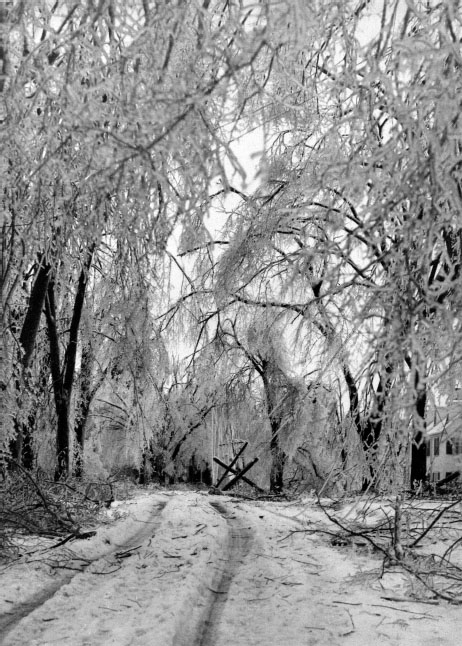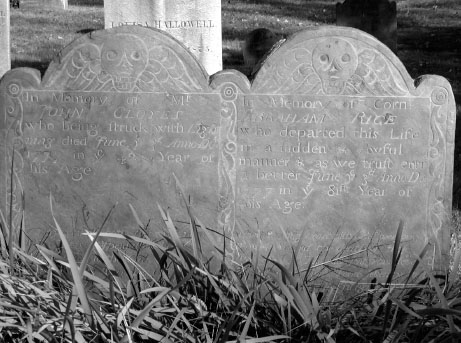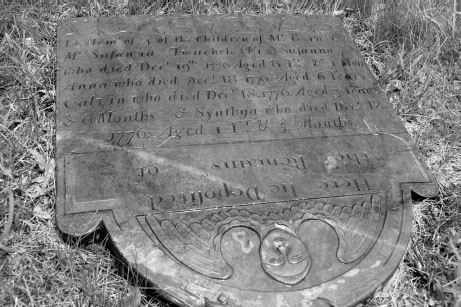Framingham Legends & Lore (11 page)
Read Framingham Legends & Lore Online
Authors: James L. Parr


Aftermath of the ice storm of January 21, 1921, in Framingham Centre.
T
HE
R
EVEREND
J
OHN
S
WIFT
Framingham's earliest weather chronicler may have been its first minister, the Reverend John Swift. The twenty-one-year-old Milton native was ordained October 8, 1701, although he had been preaching in the town for a year prior. The town then set about providing him with a house and fenced-in pasture on the ministerial land set aside by Thomas Danforth, encompassing the east side of Bare Hill to the Sudbury River. Nevertheless, Swift often had to confront the town elders, as the town was not always prompt or thorough in living up to the letter of its agreement to furnish the minister with firewood or other payment in kind. Despite these hardships, he was apparently never tempted to move, as he was still serving as Framingham's minister when he died on April 24, 1745.
Reverend Swift made many weather observations in his journal over a ten-year period, limiting his descriptions to either short passages or one or two words, sometimes in Latin, even when the event called for a more detailed account. For example, a storm in February 1717 that dropped six to seven feet of snow on Framingham and is today considered one of the worst storms of the eighteenth century was simply noted by Reverend Swift in his journal as “deep snow.”
On the evening of October 29, 1727, an earthquake that has since been estimated at a magnitude of 5.5 on the modern Richter scale struck the Northeast from Maine to Philadelphia. Eyewitness accounts across the state give great detail to the event. The quake struck shortly after eleven o'clock at night with a noise like booming cannons. It lasted for about two minutes, shaking chimneys loose and causing windows and doors to fly open. Cattle ran across fields bellowing in confusion and fear; dogs barked wildly in homes and in the streets. In Boston and surrounding towns, terrified citizens gathered in churches, seeking reassurance from their ministers that the quake was not a punishment or judgment from an angry God. For weeks following the quake, pastors preached about its meaning and the lessons to be learned from such an event. A forty-five-page sermon delivered in Boston the Sunday after the tremor by Boston's Reverend Cotton Mather was later published and sold under the grand title “A Short Essay to preserve and strengthen the Good Impressions Produced by Earthquakes on the Minds of People that have been Awakened with them, With some Views of what is to be Further and Quickly look'd for.” Incredibly, a tremor felt in Amesbury, Massachusetts, in October 2007 and measuring 1.8 on the Richter scale is believed to have been an aftershock of the 1727 quake felt 280 years later.
And what did the Reverend John Swift scribe in his journal on this fearful day? A short Latin phrase loosely translated into: “Between ten and eleven at night the earth moved in a dreadful and intense manner.”
T
HUNDER
S
ENT FROM
H
EAVEN
On June 3, 1777, John Clayes, a prominent farmer and great-grandson of accused witch Sarah (Towne) Clayes, agreed to assist Framingham's new minister Laban Wheaton in the purchase of a horse and gathered several friends together at his farm on Salem End Road to look over the animal. While the skies on that late spring day were slightly overcast, they gave no warning of the tragedy that was about to occur. One of the friends, Selectman Peter Parker, mounted the horse and took it for a short run across the field and back as a few drops of light rain fell. After Parker dismounted, the forty-two-year-old Clayes grabbed the reins and, in an instant, was on the ground, dead. A bolt of lightning had struck the horse, traveled through the animal into the earth and knocked the entire party to the ground. The lightning had also killed the horse, as well as eighty-one-year-old Abraham Rice. Peter Parker, Simon Pratt and Pratt's young son Ephraim were injured, Parker and the elder Pratt severely so. The event provided citizens of the day an opportunity to contemplate the deeper meanings of life and its unexpected sorrows. A contemporary account of the incident was published “to this world of sorrow and death as a momento [
sic
] for the improvement of life.” An elegy written by Framingham schoolteacher and poet Lydia Learned helped promote the idea that the victims were being punished by God for conducting business on the Sabbath, although the tragedy actually occurred on a Tuesday:

Gravestone of lightning victims John Clayes and Abraham Rice, with verse by Lydia Learned.
Photo by Edward P. Barry
. Gravestone of lightning victims John Clayes and Abraham Rice, with verse by Lydia Learned.
Photo by Edward P. Barry
.
Oh may you all both far and near
Who of this dispensation hear
Now harken to the call of heaven
And take the warning God has given
Surprising death to you soon may
Come in some unsuspecting way
Pray that all make it their care
For sudden death now to prepare
My trembling heart with grief o'erflows
While I record the death of those
Who died by thunder sent from heaven
In seventeen hundred seventy-seven
Almost a century and a half later, another lightning strike hit Framingham, again with tragic results. Members of the Massachusetts Volunteer Militia had just completed a ceremony on the old Musterfield on the afternoon of August 17, 1917, when a storm of biblical size suddenly broke over the camp. A bolt of lightning struck the center of the parade ground, knocking fifty soldiers to the ground. Corporal Edward P. Clark of Natick and Private Patrick J. Sullivan of Framingham were killed instantly and a dozen others were seriously injured. Several of the injured were revived by the use of a “pulmotor,” an early artificial respiration device. The erratic nature of lightning caused an unusual injury to Sergeant Martin Fair of Natick, who was left with the shape of a cross burned into his arm after the strike.
T
HE
O
LD
B
URYING
G
ROUND
Peter Clayes and Abraham Rice, the two men killed by lightning in 1777, were buried in the Old Burying Ground, under an unusual double gravestone with the first few stanzas of Lydia Learned's poem carved into it.
The Old Burying Ground on Main Street, sometimes called the Church Hill Burying Ground, is situated on a shady hill overlooking the Sudbury River. Rows of gray slate stones tipping at various angles line the grassy paths, the occasional American flag designating the grave of a war veteran. At first glance, the graveyard looks like a typical one found across New England; a closer inspection reveals stories behind the stones that are unique to Framingham.
The burying ground was laid out next to the new meetinghouse in 1698, although the oldest surviving stones date back to 1704. It is possible that the first graves were marked with wood, simple boulders or not marked at all. Sometimes a grave was covered with a large stone rectangle called a “wolf” stone, placed there to keep out scavenging animals. Eventually, the meetinghouse was relocated and the graveyard became the municipal burial ground. The town hired Samuel Barton as the official gravedigger, paying him three shillings per adult grave dug. Until the town purchased a hearse in 1794, coffins were carried to burial services on the shoulders of male mourners. One of the primary responsibilities of the caretaker was to keep the grass neat and tidy. This job could entail chasing cows away, as caretaker Jonathan Maynard was called upon to do, or supervising sheep as they pastured in the burial ground keeping the briers down, as Lawson Buckminster was paid to do in 1826.
The stones in the burial ground are adorned with a variety of symbols. From ominous winged skulls to peaceful angels, hopeful fingers pointing skyward, willows and urns, the carvings reflect the changing attitudes toward death over the centuries. Many of the names carved on the markers are the same as those found on street signs and public buildings across townâBuckminster, Eames, Hemenway, Maynard. The oldest stone in the graveyard is marked simply with the date of death, September 25, 1704. Some local historians have speculated that this grave may be that of Salem refugee Sarah Clayes, who died that year. Eighty-one soldiers who fought in the Revolution are buried here, including, of course, Peter Salem, the hero of Bunker Hill. Most of the other figures we have met in the preceding pages were also laid to rest here: Jonathan Maynard (1752â1835); Deacon William Brown (1723â1793), who had owned Crispus Attucks; Thomas Nixon Jr. (1762â1842), the Revolutionary War fifer; Jonas Clayes (1788â1856), who fashioned House Rock into millstones; and the Reverend John Swift (1679â1745), the town's first minister, whose table monument occupies a special position in the graveyard on the spot where the pulpit had stood in the original 1698 meetinghouse.

The “recycled” gravestone of the Twitchell children.
Photo by Edward P. Barry
.
An ornate wrought-iron fence surrounds the plot of the Buckminster family, signifying their wealth and prestige in town. At its center, raised above the other stones, is the monument to Colonel Joseph Buckminster (1697â1780), who played such a memorable role in town affairs, as chronicled in these pages. Also inside the plot is the relatively recent and unusual stone of Joan Buckminster Marcy, who died in 1942 at the age of fourteen. Atop the flat bronze marker inscribed with her name and birth and death dates is the statue of a whimsical bronze turtle.
Not far from the Buckminster plot is the poignant grave of the Twitchell children. Susanna, Anna, Calvin and Cynthia, ranging in age from one to eight years, all died within a two-day period in December 1776. Over the years, time and weather heaved the marker so that another, upside-down inscription began to appear. Eventually the whole stone was uprooted from the ground, revealing the entire surface. The bottom of the Twitchell stone is in fact the top of a stone that may have been reused by the carver after making a mistake. A winged angel and the partial inscription “Here lies deposited the remains of” are carved into the curved end of the stone. Such “recycled” stones are fairly common in old New England graveyards.
T
HE
S
MALLPOX
G
RAVEYARD
Not all of Framingham's dead were interred in town cemeteries. Many families chose to bury their loved ones close to home in pastures and woodlands, especially in the sparsely populated north side of town. When former farmland began to be developed for housing in the mid-twentieth century, contractors and town officials had to deal with the problem of these random, isolated graves. The existence of a smallpox graveyard was no secret in 1964 when the Lanewood subdivision was being built off Pleasant Street. Finding the graves and relocating them was a different story.
Framingham experienced an outbreak of smallpox in 1793. As we have already seen in the tragic case of the four Twitchell children, the spread of fatal contagious diseases was a constant threat in the era before modern medicine. Most of these devastating outbreaks probably went unrecorded, especially if they only affected a household or two. There were some larger onesâthe first four months of 1754 brought a “fatal distemper” to the region, which became known as the “Great Sickness.” It was especially lethal in Holliston, where it killed fifty-three, but it also struck Framingham. Smallpox itself had already come twice before in the decades prior to the 1793 outbreakâin 1764, when it was carried back by the returning servicemen from the French and Indian War, and in 1777, when it was probably likewise brought to the town by the extensive travel occasioned by the Revolution.
